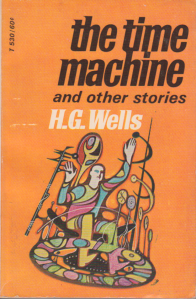The Book: The Time Machine from The Time Machine and Other Stories by Herbert George (H.G) Wells. Novella first published in 1895. The edition read was published in 1969 (copyright 1963) by Scholastic Book Services.

The Setting: Earth during an unspecified present (one assumes the Victorian era) directly. Earth in the year 802,701 by proxy.
The Story: The narrator, a weekly dinner guest of the Time Traveler, relates his experiences at two dinners. More specifically, he relays the tale told by the Time Traveler of his harrowing adventures in the distant future 802,701. The Time Traveler, in the future, discovers two races upon the earth – the gracile, childlike Eloi and the apelike, subterranean Morlocks. He makes various theories about their origins and concludes that they represent the human race, with the Eloi evolved from the elite upper classes and the Morlocks evolved from a worker class. He attempts to confront the Morlocks, who have hidden his time machine, but is foiled by the darkness. When, eventually, he finds his vehicle, he escapes by the skin of his teeth from the Morlocks into an even more distant future, in the year about 30 million. There he finds himself on a desolate beach under a red sky and is attacked by scary crab creatures. Eventually, he gains control of himself and returns home to his dinner party where he eats some mutton and tells his adventures to his guests.
The Science: Science? Well, I guess there’s evolution. The story rather relies on belief in the theory of evolution to make it work, so I’m not sure how Pastafarians would receive the story. As far as time travel goes, all we know is that the machine is rather frail, and there’s some quartz and nickel involved in it. There’s some discussion of a theory of time travel, which is fine, but the actual mechanics of it are rather left by the wayside. And the scene at the end, in the very distant indeed future, brought to my mind the evolution sequences in Don Hertzfeldt’s The Meaning of Life. I think most of the project will be more Wellsian than Vernian – more “and this science-y thing happened” than “and this is the science that made the thing happen.”
The Reaction: I was underwhelmed, but I had a lot of preconceived ideas going into it. I’m sure I’ve seen at least three different versions of the story on film before ever actually reading the book. It was a good story – a story of discovery and speculation. The only facts are what is seen; everything else is speculation. I believed the tendency of the Time Traveler to constantly make up and revise theories about what he was confronted with, because that’s what I do every day. For me, the most exciting part of it is at the very end, wherein the narrator witnesses the disappearance of the time machine. I liked the potential of that moment. Up until then, everything in the story was certain. We know the Time Traveler escapes the Morlocks, because he’s telling the story. But when he leaves again… we don’t know the future anymore.
The Cover: Oh the cover! Clearly, it is the Time Traveler in his time machine. But what is going on? Why is there a giant spoon behind him? Why does it appear to have been colored in by a nine year old with access to only five crayons? The world may never know. Full points for relevance. Points off for limited crayon selection.
Next Up: The Invisible Man, also by H.G. Wells






